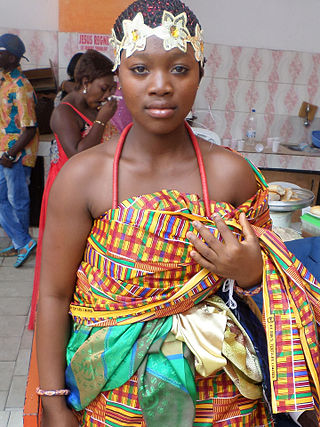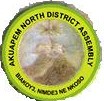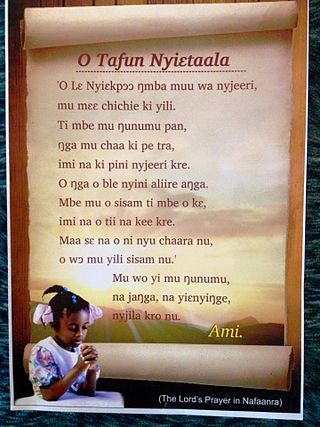Gallery
- Sacred Grove and Shrine
- Tano Rock Shrine in Tanoboase, Ghana
- Tano Rock Shrine located in Tanoboase, Ghana
- Located in Tanoboase, Ghana
- Inside the Tano Rock Shrine with tour guide in Tanoboase, Ghana
Tanoboase Sacred Grove and Shrine is near the village of Tanoboase in the Techiman, Brong Ahafo region of Ghana. It is believed to be the cradle and the traditional home of the Bono people. It is said by the Tanoboase people that powerful Ashanti Gods reside in the sacred grove. Historically the site is where Ashanti Wars were fought. The grove was a hideout during the slave trade and inter-tribal wars. The grove is also a place for religious activities. [1]
Tano is the name given to several gods. The word Tano has its origins in the Tano River.
The Tano sacred grove and shrine is one of many sacred groves in Ghana, West Africa. The rock shrine is inside of the sacred grove. Inside the rock shrine is the original brass pan. There are five compartments, the main entrance, durbar ground, hideout, watch tower and stairs.
It is an oasis that maintains biodiversity in culture and religious based knowledge system. Mike Anane writes, "It is gratifying that in Ghana today, some NGOs and scholars are recognizing the importance of various traditional religious beliefs or culture-based knowledge systems in addressing alarming problems of environment and development ... The old 'top-down' or paternalistic forms of development can no longer be enough in the face of environmental catastrophe." [2]
In 1996, the Grove became a Community Based-Ecotourism Project (CBEP). [3]
The Tanoboase Sacred Grove and Shrine is part of Ghana's material cultural heritage.
In 2001, the Sacred grove was selected to be an eco-tourism site with the support of the Ghana Association for the Conservation of Nature (GACON). [4]
The Tano sacred grove and rock shrine is a traditional conservation practice bedded in indigenous religion of the Bono people of Ghana. The sacred grove is believed by the Bono people to be the abode of local gods, and ancestral spirits. It is also the home of super natural beings. [5]
Oral tradition is passed down from generation to generation about the founding of the sacred grove. Legend is that the deity Taakora manifested to Afya Ankomah with instructions to follow. The instructions enabled the Bono people to live in the rock caves. The instructions were that the people were not to hunt or farm in the sacred grove. The caves were shelter. They gave the Bonos security and were used as hideouts for kings. [3] [6]

The Mfantsefo or Fante are an Akan people. The Fante people are mainly located in the Central and Western regions of Ghana, occupying the forest and coastal areas. Their land stretches from the Pra estuary in the west to the Accra borders in the east. The Fante can be broadly categorized into two groups - the Borbor Fante and the non-Borbor Fante. Over the last half century, due to fishing expeditions, Fante communities have been established as far as Gambia, Liberia and even Angola. Major Fante cities in modern Ghana include Kasoa, Winneba, Agona Swedru, Tarkwa, Oguaa, Edina (Elmina), Mankessim, Sekondi, and Takoradi.

Sacred groves or sacred woods are groves of trees that have special religious importance within a particular culture. Sacred groves feature in various cultures throughout the world.
Techiman is a city and is the capital of Techiman Municipal and Bono East Region of Ghana. Techiman is a leading market town in South Ghana. Techiman is one of the two major cities and settlements of Bono East region. Techiman is home to West Africa's largest traditional market. Techiman has a settlement population of 104,212 people in 2013. Techiman is located at a historical crossroads of trade routes and the Tano River, and serves as capital of the Techiman Municipal District.

The Brong-Ahafo region was a region in central Ghana. Brong-Ahafo was bordered to the north by the Black Volta river and to the east by the Lake Volta, and to the south by the Ashanti, Eastern and Western regions. The capital of Brong-Ahafo is Sunyani. Brong-Ahafo was created on 14 April 1959 from the then Western Ashanti and named after the main ethnic groups, the Brong and Ahafo. In 2019, as a result of the 2018 Ghanaian new regions referendum, the region was divided into three, namely Bono, Bono East and Ahafo regions, and ceased to exist.
The Akan people are a Kwa group living primarily in present-day Ghana and in parts of Ivory Coast and Togo in West Africa. The Akan speak dialects within the Central Tano branch of the Potou–Tano subfamily of the Niger–Congo family. Subgroups of the Akan people include: the Agona, Akuapem, Akwamu, Akyem, Anyi, Ashanti, Baoulé, Bono, Chakosi, Fante, Kwahu, Sefwi, Wassa, Ahanta, and Nzema, among others. The Akan subgroups all have cultural attributes in common; most notably the tracing of matrilineal descent in the inheritance of property, and for succession to high political office.
Bono State was a trading state created by the Bono people, located in what is now southern Ghana. Bonoman was a medieval Akan kingdom in what is now Bono, Bono East and Ahafo region respectively named after the and Eastern Ivory Coast. It is generally accepted as the origin of the subgroups of the Akan people who migrated out of the state at various times to create new Akan states in search of gold. The gold trade, which started to boom in Bonoman as early in the 12th century, was the genesis of Akan power and wealth in the region, beginning in the Middle Ages.

The Bono, also called the Brong and the Abron, are an Akan people of West Africa. Bonos are normally tagged Akan piesie or Akandifo of which Akan is a derivative name. Bono is the genesis and cradle of Akans. Bono is one of the largest ethnic group of Akan and are matrilineal people. Bono people speak the Bono Twi of Akan language. Twi language, thus the dialect of Bono is a derivative of a Bono King Nana Twi. In the late fifteenth century, the Bono people founded the Gyaaman kingdom as extension of Bono state in what is now Ghana and Côte d'Ivoire.
Articles related to Ghana include:

Akropong is a town in South Ghana and is the capital of the Akuapim North District, a district in the Eastern Region of South Ghana. This town is known for producing snails and palm oil. Akropong has a 2013 settlement population of 13,785 people.
Bono, also known as Abron, Brong, and Bono Twi, is a Central Tano language common to the Bono people and a major dialect of the Akan dialect continuum, and thus mutually intelligible with the principal Akan dialects of Asante and Akuapem, collectively known as Twi. It is spoken by 1.2 million in Ghana, primarily in the Central Ghanaian region of Brong-Ahafo, and by over 300,000 in eastern Ivory Coast.
The Akan people appear to have used a traditional system of timekeeping based on a six-day week. The Gregorian seven-day week is known as nnawɔtwe (eight-days). The combination of these two system resulted in periods of 40 days, known as adaduanan.
The Apoo Festival is a festival celebrated annually in western Ghana, lasting a week in March and April. The festival is meant to ritually purify the people of social evils, as well as uniting people and families, and includes a variety of other traditional cultural activities. The word 'apoo' comes from the root word 'po', meaning 'to reject.'

Akan religion comprises the traditional beliefs and religious practices of the Akan people of Ghana and eastern Ivory Coast. Akan religion is referred to as Akom. Although most Akan people have identified as Christians since the early 20th century, Akan religion remains practiced by some and is often syncretized with Christianity. The Akan have many subgroups, so the religion varies greatly by region and subgroup. Similar to other traditional religions of West and Central Africa such as West African Vodun, Yoruba religion, or Odinani, Akan cosmology consists of a senior god who generally does not interact with humans and many gods who assist humans.

Banda Ahenkro is a town located in the west-northern of Bono region, Ghana, near the border of Ivory Coast. Its geography provided a home for numerous groups seeking shelter from across West Africa during the slave trade era. The original name of the settlement was Serminakuu meaning groups of 'grasses'. This name was changed to Banda, which is a corruption of 'Woanda' meaning 'they did not sleep'. Ancestors of Banda Ahenkro were allies of the Asante kingdom during wars and they provided a military force that virtually refused to sleep during at-war times. This is because they were predominantly Muslims and were found praying throughout the night. Later, 'woanda' was also corrupted by the Bono neighbours to become Banda. The settlement evolved to become the chief town or 'Ahenkro' within a collection of Nafana communities.

The Ahafo Region is a newly created region in Ghana with Goaso as its capital. The region has administrative and governmental legislature like all the ten already existing regions in Ghana. The region was carved out of the south-eastern part of the Brong Ahafo Region and was in fulfillment of a campaign promise made by New Patriotic Party. Prior to the 2016 Ghanaian general election, the then candidate Nana Akufo-Addo declared that when elected, he would explore the possibility of creating new regions out of some of the existing regions in Ghana in order to bring government closer to citizens.
Atebubu College of Education is a teacher education college in Atebubu. The college is located in Ashanti / Brong Ahafo zone. It is one of the 46 Public Colleges of Education in Ghana. The college participated in the DFID-funded T-TEL programme. It was founded in October 1965. it was the premier second cycle institution and also the only teacher training college in the eastern corridor of the region.

The Bono region is one of the 16 administrative regions of Ghana. It is as a result of the remainder of Brong-Ahafo region when Bono East region and Ahafo region were created. Sunyani, also known as the green city of Ghana, is the regional capital. Sunyani can pride itself as the cleanest capital city and a major conference destination.

The Bono East region of Ghana is a new region carved out of the Brong Ahafo region. The capital of the new region is Techiman. This creation of this new region was in fulfillment of a promise made by the New Patriotic Party prior to the 2016 Ghana general election. Upon winning the elections, the President, Nana Akuffo Addo created the Ministry of Regional Reorganization to oversee policy formulation and implementation. In all six new regions are to be created from the existing ten regions of Ghana. The other regions are Bono, Western North, Ahafo, Savannah, North East, and Oti regions.
Tano (Tanoɛ), whose true name is Ta Kora, but is often confused with Tano Akora, and is known as Tando to the Fante is the Abosom of war and strife in Akan mythology and Abosom of Thunder and Lightning in the Asante mythology of Ghana as well as the Agni mythology of the Ivory Coast. He represents the Tano River, which is located in Ghana. He is regarded as the highest atano, or Tano abosom in Akan mythology.
Ghana was initially referred to as the Gold Coast. After attaining independence, the country's first sovereign government named the state after the Ghana Empire in modern Mauritania and Mali. Gold Coast was initially inhabited by different states, empires and ethnic groups before its colonization by the British Empire. The earliest known physical remains of the earliest man in Ghana were first discovered by archaeologists in a rock shelter at Kintampo during the 1960s. The remains were dated to be 5000 years old and it marked the period of transition to sedentism in Ghana. Early Ghanaians used Acheulean stone tools as hunter gatherers during the Early stone age. These stone tools evolved throughout the Middle and Late Stone Ages, during which some early Ghanaians inhabited caves.